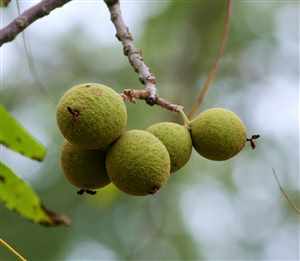Black walnut (Juglans Nigra)
Main Facts about Black walnut

Using Black walnut
A strong anti-parasite and mitosis inhibitor. Rich in iodine, important for production of thyroid hormones. Green hulls of black walnut are even better for anti-parasite action. Leaf tea is astringent (bleeding, diarrhea), insecticide against bedbugs, anti-fungal against athlete’s foot (ringworm), lice, and very strong sedative. Leaf tea also used for eczema, hives and boils.Black walnut is a remedy for: Anxiety
Cooking with Black walnut
After collecting, remove husk from nuts and let them dry for a couple of weeks. Then put them in water. Throw out any that float. Put in hot water and soak for a day (water can cool down while soaking). Throw out water, add new hot water and soak a couple more hours. Then remove shells and seal in glass jars in refrigerator for up to a year. The green hulls can be ground into a powder and used for parasite killing internally or externally. Inner bark is laxative. Do not use internally if pregnant.How to grow Black walnut
Black walnut is slow-growing especially if not in its preferred moist, fertile, sunny site. Trees start producing after 12-15 years. The nuts ripen in September or October. These trees are not easy to transplant since they have a deep taproot. Seeds or seedlings should be planted. Walnuts should be stratified (placed in a cold location) before planting. This plant does not do well in competing for nutrients and water, so make sure the land around them is well weeded. Nuts may become a nuisance as they litter and stain. Foliage is often attacked by caterpillars, and the species is susceptible to anthracnose which defoliates trees for the season. Can be toxic to certain trees and plants if planted too close.| Bilberry |
Broad bean
|